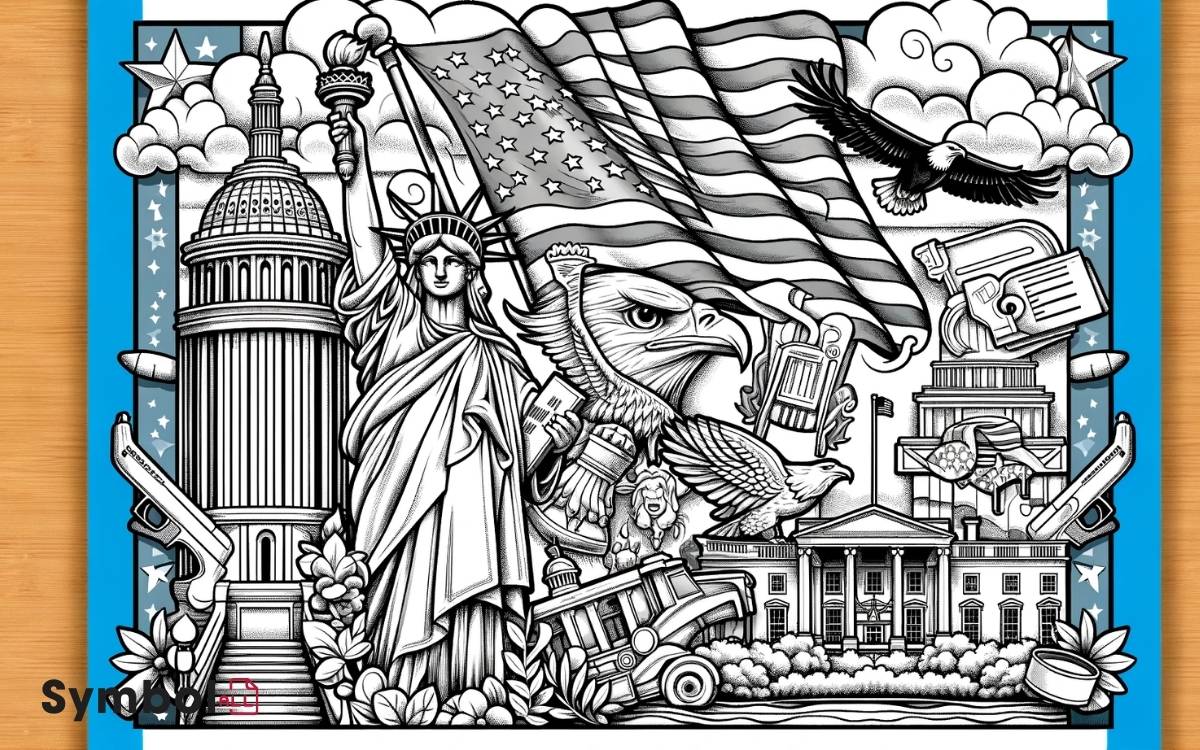United States Symbols Coloring Pages? Find Out Here!
You’re on a quest for United States symbols coloring pages, and you’re in luck. Imagine coloring the American Flag‘s vibrant stripes and stars, each hue telling its own story of valor, purity, and vigilance.
Picture bringing the powerful Bald Eagle to life, an emblem of American freedom. Or the Statue of Liberty, a towering symbol of welcome.
Don’t forget the Liberty Bell, with its rich history, and the iconic White House, standing as a proof of American leadership.
Exploring these coloring pages is not just an activity; it’s a journey through the heart of American values and history. Plunge in, and let your creativity uncover more wonders.

Key Takeaway
The American Flag
The American Flag, a symbol of freedom and unity, stands tall as one of the most recognizable emblems of the United States.
You’ve likely seen it fluttering in the breeze, its stripes and stars a vivid reminder of the country’s enduring spirit.
Comprising thirteen stripes that represent the original colonies and fifty stars symbolizing the current states, this flag isn’t just a piece of cloth; it’s a story woven through America’s history.
When you’re coloring the American Flag, each hue holds significance: red for valor and bravery, white for purity and innocence, and blue for vigilance, perseverance, and justice.
Capturing these colors on your page, you’re not just filling in sections; you’re embracing and celebrating the rich tapestry of the nation’s identity and values.
The Bald Eagle
Soaring high above the land, the Bald Eagle represents the United States‘ spirit of freedom and strength.
This majestic bird, with its wide wingspan and sharp eyes, symbolizes the country’s ideals of liberty and independence.
Chosen as the national emblem in 1782, the Bald Eagle holds a special place in Americans’ hearts. Its image adorns various official seals, including the Great Seal of the United States, reflecting its importance to American identity.
You’ll find the Bald Eagle in various habitats across North America, from Alaska’s cold environments to the warm climates of Florida.
Coloring its distinctive white head and tail, yellow beak, and dark brown body and wings can be a fun way to connect with this symbol of American resilience. Enjoy bringing this iconic bird to life through your creativity.
The Statue of Liberty
Just as the Bald Eagle lifts its wings above the American landscape, the Statue of Liberty stands tall as a beacon of hope and freedom in New York Harbor.
Here’s why you should grab your crayons and start coloring this iconic symbol:
- Historic Significance: Gifted by France in 1886, it symbolizes the friendship between the two nations and the pursuit of liberty.
- Architectural Marvel: With its towering height and intricate design, the statue is a feat of engineering.
- Symbol of Welcome: It has greeted millions of immigrants, representing new beginnings.
- Global Icon: Recognized worldwide, it embodies freedom and democracy.
Coloring the Statue of Liberty isn’t just an artistic endeavor; it’s a way to connect with the values it represents.
The Liberty Bell
You’ll learn about its rich history, from its creation to its iconic crack, and why it’s such a significant symbol in the United States.
This exploration will deepen your understanding of the bell’s role in American history and its enduring legacy.
Liberty Bell History
The Liberty Bell, an iconic symbol of American independence, has a rich history dating back to its casting in 1752 in Philadelphia. You might find its journey from then to now both fascinating and enlightening.
Here’s a snapshot:
- Casting and Recasting: Originally cast in London, the bell cracked on its first test ring. It was recast in Philadelphia by local craftsmen John Pass and John Stow.
- Proclaiming Liberty: It rang to summon citizens for the reading of the Declaration of Independence on July 8, 1776.
- The Famous Crack: Despite several attempts to repair it, the bell developed a significant crack that rendered it unringable.
- A Symbol Moves: The bell was moved several times before finding its permanent home at the Liberty Bell Center in Independence National Historical Park.
Discovering the Liberty Bell’s history offers a glimpse into the heart of American identity.
Symbolism and Significance
Beyond its physical presence, the Liberty Bell embodies the enduring spirit of American freedom and independence.
This iconic symbol isn’t just a relic of the past; it’s a beacon that continues to inspire countless people.
The crack that marred its surface has come to represent the nation’s journey through conflict and reconciliation, highlighting the imperfections and resilience in the pursuit for liberty. When you see the Liberty Bell, you’re not just looking at a piece of history.
You’re witnessing a validation to the unbreakable will of a nation aspiring to uphold the principles of freedom and justice.
Its ringing may have ceased, but its message resonates louder than ever, urging you to remember the sacrifices made for the freedoms you enjoy today.
The White House
As you color the White House, remember it’s not just the residence of the President; it’s a symbol of America’s history and democracy. Its architectural features tell a story of evolution and resilience, reflecting the nation’s journey.
Understanding its historical significance and unique design will deepen your appreciation for this iconic building.
Historical Significance
Standing as a symbol of democracy and leadership, the White House has played a pivotal role in American history since its completion in 1800. It’s not just a residence for the President; it’s a witness to the nation’s growth and challenges.
Here’s why it’s significant:
- Center of Power: It’s been the executive mansion for every U.S. President except George Washington.
- Historical Decisions: Critical decisions affecting the nation and the world have been made within its walls.
- Symbol of Proof: Surviving fires and renovations, it stands as a token to the nation’s endurance.
- Cultural Impact: It’s a key location for state functions and a symbol in American culture, inspiring respect and recognition worldwide.
The White House’s story intertwines with the nation’s, marking its importance in the U.S. and beyond.
Architectural Features
The White House, with its neoclassical architecture, embodies the ideals of democracy through its intricate design and historical features.
This iconic building showcases a facade made from Aquia Creek sandstone, painted white, which is where it gets its name.
You’ll find its grand porticos, the North and South, adding to its majestic appearance. The North Portico faces Pennsylvania Avenue and serves as the official entrance, while the South Portico overlooks the South Lawn, offering a more picturesque view.
Inside, its design includes a variety of symbols representing the nation’s history and values. The architectural details, from the Corinthian columns to the intricate molding and the grand staircase, tell a story of the nation’s journey.
It’s a masterpiece that stands as a symbol of the United States, inviting you to explore its rich history and architectural beauty.
Presidential Residence
Nestled in the heart of Washington, D.C., the White House isn’t just an architectural marvel; it’s been the official residence and workplace of every U.S. president since John Adams in 1800.
This iconic building isn’t only a symbol of leadership and governance, but also a home filled with history and stories.
Here’s why you’ll find it fascinating:
- Historical Significance: It’s a living museum of American history.
- Architectural Splendor: Its design combines neoclassical and modern styles.
- Cultural Symbol: Represents the executive branch of the U.S. government.
- Accessibility: Public tours reveal its public rooms, gardens, and famous Oval Office.
Engaging with this symbol enriches your understanding of American heritage, making it more than just a coloring page.
The Lincoln Memorial
You’ll find the Lincoln Memorial, an iconic symbol of freedom and equality, located in Washington, D.C., honoring the 16th President of the United States, Abraham Lincoln.
This majestic structure invites visitors from around the globe to reflect on the values Lincoln stood for.
As you explore its grand steps and gaze upon the statue of Lincoln, you’re reminded of the enduring impact of his leadership during one of America’s most tumultuous times.
| Feature | Description | Significance |
|---|---|---|
| Location | Washington, D.C. | Symbolizes national unity |
| Dedicated to | Abraham Lincoln | Honors freedom and equality |
| Architectural Style | Greek Doric columns | Reflects ancient democracy |
Engaging with this memorial offers a profound connection to American history and the ideals that continue to shape the nation.
Mount Rushmore
Carved into the granite face of South Dakota’s Black Hills, Mount Rushmore stands as a monumental tribute to four of the United States’ most influential presidents.
You’ll find this iconic sculpture captures the essence of American resilience and ambition. It’s a breathtaking sight that draws millions of visitors each year, excited to gaze upon the faces of George Washington, Thomas Jefferson, Theodore Roosevelt, and Abraham Lincoln.
These leaders were selected for their roles in preserving the Republic and expanding its territory.
Here’s why Mount Rushmore is a must-see:
- Historical Significance: Each president represents a different era and pivotal moment in U.S. history.
- Artistic Marvel: The craftsmanship involved in sculpting these massive portraits is awe-inspiring.
- National Symbol: It embodies American ideals and democracy.
- Educational Experience: Provides a unique way to learn about U.S. history and heritage.
The Great Seal
After exploring the monumental grandeur of Mount Rushmore, let’s turn our attention to another symbol steeped in history, The Great Seal of the United States. Adopted on June 20, 1782, this emblem encapsulates the beliefs and values that the country stands for.
At its center, you’ll find the bald eagle, the nation’s bird, clutching an olive branch and arrows in its talons, symbolizing a preference for peace but readiness for war. The eagle faces the olive branch, emphasizing peace.
Above its head, a constellation of 13 stars represents the original states united in a single purpose.
Surrounding this are the words, “E Pluribus Unum,” meaning ‘Out of many, one,’ highlighting the unity and diversity of the U.S. It’s not just a seal; it’s a story of unity, strength, and independence.
The U.S. Capitol
As we explore the heart of America’s political landscape, the U.S. Capitol stands as a beacon of democracy, embodying the nation’s legislative soul.
This iconic edifice isn’t just a building; it’s a symbol of the American people’s resilience, history, and unity.
Here’s why it’s a must-have on your coloring pages:
- Historical Significance: It’s the meeting place of the United States Congress, witnessing pivotal moments in history.
- Architectural Marvel: With its distinctive dome and neoclassical design, it’s a visual feast.
- Symbol of Democracy: Represents the American principle of representative democracy.
- Cultural Icon: Featured in countless films, photos, and artworks, it’s an integral part of American identity.
Dive into coloring this symbol, and you’ll find yourself connecting with the heart of American democracy. Dive into coloring this symbol, and you’ll find yourself connecting with the heart of American democracy. Each stroke can serve as a reminder of the values and ideals that shape the nation. If you’re seeking even more inspiration, exploring the Colorado state symbols list can offer fascinating insights into the diverse natural and cultural icons that represent the Centennial State.
Conclusion
You’ve now explored the vibrant symbols that stitch the fabric of the United States together. From the unwavering strength of the Bald Eagle to the solemn grandeur of the Lincoln Memorial, each symbol paints a unique piece of the American story.
Did you know the American flag has been modified 27 times since its initial design in 1777? It’s a proof to the nation’s evolving identity.
So grab your crayons, and let’s bring these symbols to life, coloring page by coloring page.






